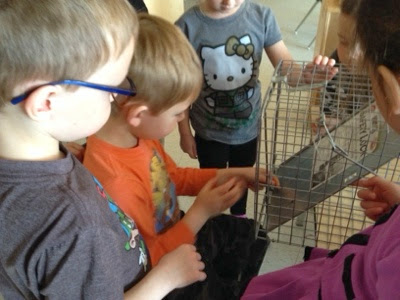As a team, we decided to listen to the children's interests and facilitate an inquiry into traps and enclosures. Using the inquiry process (wonder --> explore --> plan --> experiment --> observe --> share ideas), we'll be exploring the following ideas:
-Traps (what are they, how to make one, mechanics)
-Hiding and chasing (safety, danger)
-Enclosures and cages (necessities of life, strong structures)
-Ethics (Why do people trap? Should we just do it for fun? Empathy with animals etc)
Throughout the inquiry, we'll be embedding the activities with literacy, numeracy, art, science, and imaginative play.
Today, I brought in a small animal trap as a provocation. The children were fascinated by the mystery item under the sheets.
 |
| "I think it's a cage! I see squares through the blankets. There's a little door in there." |
After observing and wondering, the children made lots of guesses, ranging from rocket ship to a mailbox to a cage. They observed the noise it made and felt the bars with their hands, coming to the conclusion that it was made of metal.
It took a few more minutes and some teamwork to figure out how to set the trap.
 |
| "What does this do? It's like a ramp. Maybe for cars?" "No, it's for the skunk. He gets his tail trapped there and he can't get out." |
It didn't take long for the children to start role-playing with some of our plastic animals. They were delighted by the door quickly closing and catching the creatures.
We had an interesting discussion about whether we should use the trap for real animals. Do we trap for fun? Or only when we really need to? How would you feel caught in a trap?
 |
| The boys read the caution on the trap about wearing thick gloves when handling a trapped animal. |
It will be interesting to see how the children's ideas emerge and mature over the course of our work. As we progress, the teachers will continue to collect data and tailor the learning for each child involved.




No comments:
Post a Comment